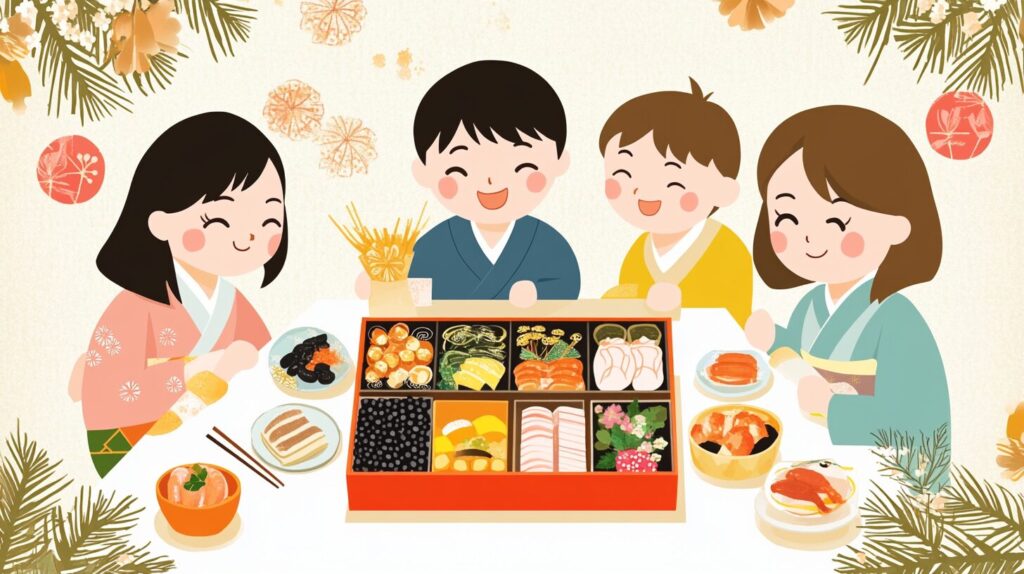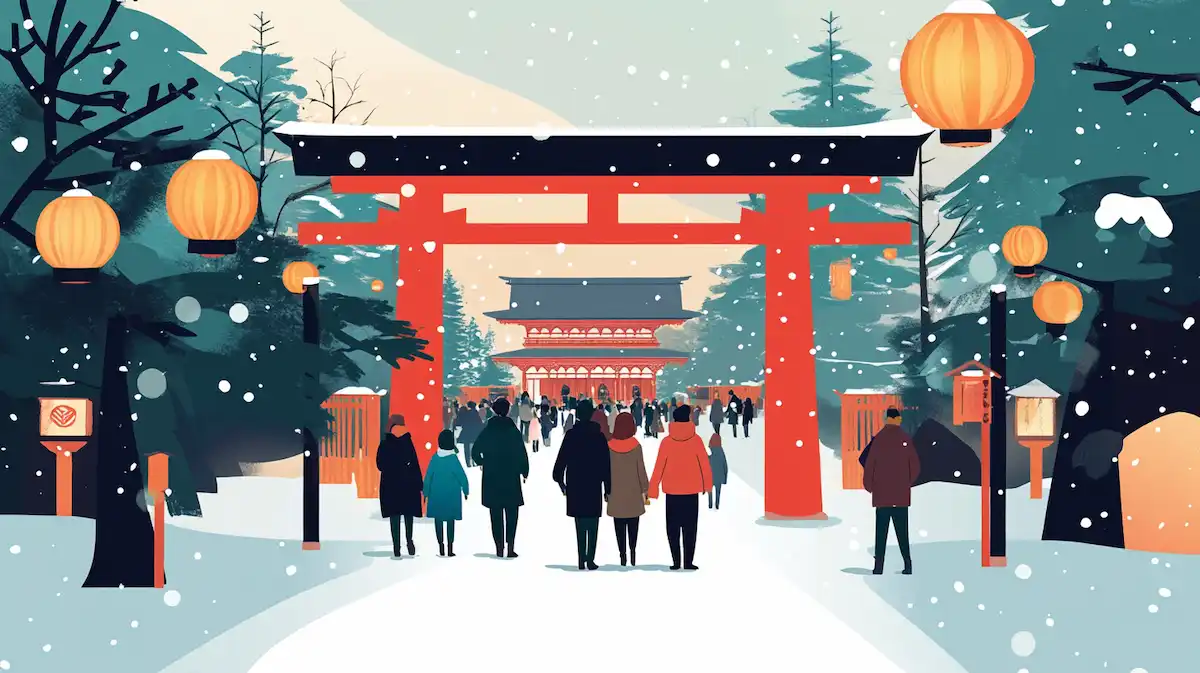おせち料理を英語で説明・紹介するための基本情報と、英会話に役立つ表現をシンプルでわかりやすい英語で紹介します。
英会話ダイアローグ・概要・10の質問を通して、おせち料理に関する英語表現を学びます。
英語
英会話ダイアローグを読む前に知っておくと良い前提知識と情報です。
- おせち料理の基本情報
- 日本の正月に食べる伝統的な料理で、縁起の良い意味を持つ料理を重箱に詰めて提供
- 新年の三が日を料理せずに過ごすため、日持ちする調理方法を採用
- 重箱に赤・白・金などの華やかな色合いで詰められ、見た目も楽しめる
- 料理ごとの意味
- 黒豆(健康・勤勉)
- 数の子(子孫繁栄)
- エビ(長寿)
- 昆布巻き(喜び)
- 現代における変化
- 家庭で手作りするほか、デパートやオンラインで購入する人が増えている
- 洋風や一人用のおせちなど、現代風に進化している
2人がおせち料理について話しています。
おせちの歴史や特徴、黒豆や数の子などの具材に込められた意味、重箱での提供などを話題にしています。
会話 / dialogue

Hey Key, I’ve been hearing a lot about osechi ryori lately. It sounds fascinating, but I don’t know much about it. Can you tell me more?

Of course, Mack! Osechi ryori is a traditional Japanese meal eaten during the New Year. It’s not just food—it’s filled with meanings and hopes for the coming year.

Meanings? Like what?

Each dish symbolizes something positive. For example, black beans (kuromame) represent good health and hard work. Kazunoko, or herring roe, stands for fertility and family prosperity. And shrimp (ebi) symbolizes long life because their curved shape looks like an elderly person’s back.

That’s so thoughtful. It’s like you’re eating good luck!

Exactly. The presentation is also special. Osechi is served in stacked boxes called jubako, which symbolize “piling up happiness.”

Wow, it must take forever to prepare.

Traditionally, yes. Families used to spend days cooking. The food is made to last several days because people avoided cooking during the first three days of the New Year.

That’s smart! But do people still make it at home?

Some do, but most people buy it now from supermarkets, department stores, or online. There are even modern variations like Western-style osechi or smaller portions for single people.

That makes sense for busy people. By the way, when did this tradition start?

It goes back over 1,000 years to the Heian period. It began as part of sechie, seasonal festivals held at the imperial court. Later, it spread to samurai and common families.

That’s amazing. So it’s been a part of Japanese culture for centuries.

Absolutely. It’s not just about food; it’s about connecting with history, family, and tradition.

Speaking of tradition, do all families eat the same dishes?

Not really. There are regional and family variations. For example, eastern Japan prefers stronger flavors, while western Japan uses lighter seasoning.

Interesting! What’s your favorite dish?

Probably kuri kinton. It’s a sweet mash made with chestnuts and sweet potatoes, and its golden color symbolizes wealth and prosperity.

That sounds delicious. I think I’d love that too. Do you have any plans to make or eat osechi this year?

I usually order a mix of traditional and modern dishes. You should try it!

I think I will. Thanks, Key. Learning about osechi makes me appreciate the culture even more.

I’m glad! It’s one of the best ways to experience Japanese New Year.

Definitely. I can’t wait to try it and “pile up some happiness” with my jubako!

Perfect mindset!
概要 / Overview
「おせち料理」について、理解を深めるための「英語での概要」です。
おせち料理

What is Osechi Ryori?
Osechi ryori is a traditional Japanese meal eaten during the New Year. It has been a part of Japanese culture for over 1,000 years, starting in the Heian period (794–1185). Originally, it was part of seasonal celebrations at the imperial court. Today, osechi is enjoyed by families across Japan to celebrate the start of a new year with hope and gratitude.
The Meaning of Each Dish
Each dish in osechi has a special meaning.
For example:
・Black beans (kuromame): Represent good health and hard work.
・Herring roe (kazunoko): Symbolize fertility and family prosperity.
・Shrimp (ebi): Represent long life because their curved shape looks like an elderly person’s back.
・Kombu rolls: Stand for joy because the word “kombu” sounds like “yorokobu,” meaning happiness.
By eating osechi, people wish for good luck, health, and happiness in the coming year.
How Osechi is Served
Osechi is usually served in stacked boxes called jubako. The stacking symbolizes “piling up happiness” for the New Year. The dishes are colorful, with red, white, and gold being common colors that represent celebration and purity. The artistic presentation makes it not only delicious but also beautiful to look at.
Traditional and Modern Osechi
Traditionally, osechi was made at home, and families would spend days preparing it. The dishes were made to last for a few days since people avoided cooking during the first three days of the New Year. Nowadays, many people buy osechi from supermarkets, department stores, or online. Modern osechi includes Western or Chinese-style dishes, smaller portions for single people, and allergy-friendly options.
Regional Differences
Osechi varies by region and family. In eastern Japan, dishes tend to have stronger flavors, while in western Japan, lighter seasoning is more common. Some families even add unique dishes based on local ingredients and traditions.
Why Osechi is Special
Osechi ryori is more than just food. It connects people to Japanese history, culture, and family traditions. By enjoying osechi, families not only celebrate the New Year but also strengthen their bonds and reflect on their wishes for the future. It’s a beautiful way to start the year with gratitude and hope.
10の質問 / 10 questions
「おせち料理」について、理解を深めるための「英語での10の質問」です。
1: What is osechi ryori?
Osechi ryori is a traditional Japanese meal enjoyed during the New Year, consisting of various dishes packed in layered boxes called jubako. Each dish has a special meaning, symbolizing wishes for the coming year.
2: When did osechi ryori originate?
Osechi ryori dates back to the Heian period (794–1185) in Japan, where it began as part of seasonal festivals called sechie at the imperial court.
3: Why are the dishes in osechi ryori significant?
Each dish in osechi ryori carries a symbolic meaning, representing hopes for health, prosperity, and happiness in the New Year.
4: What does kuromame represent in osechi ryori?
Kuromame, or black beans, symbolize good health and hard work.
5: Why is kazunoko included in osechi ryori?
Kazunoko, or herring roe, represents fertility and the wish for family prosperity.
6: What is the significance of ebi in osechi ryori?
Ebi, or shrimp, symbolizes long life because its curved shape resembles an elderly person’s bent back.
7: How is osechi ryori traditionally served?
Osechi ryori is traditionally served in stacked boxes called jubako, which symbolize the piling up of happiness and good fortune.
8: Why are osechi dishes prepared to last several days?
Osechi dishes are prepared to last several days because, traditionally, cooking was avoided during the first three days of the New Year to allow the kitchen gods to rest.
9: How has osechi ryori evolved in modern times?
In modern times, osechi ryori has evolved to include Western-style dishes, smaller portions for single individuals, and allergy-friendly options, making it more accessible and diverse.
10: Are there regional differences in osechi ryori?
Yes, there are regional differences in osechi ryori. For example, Eastern Japan prefers stronger flavors, while Western Japan uses lighter seasoning.

和訳付
会話 / dialogue

Hey Key, I’ve been hearing a lot about osechi ryori lately. It sounds fascinating, but I don’t know much about it. Can you tell me more?
ねえキー、最近「おせち料理」についてよく耳にするんだ。とても面白そうだけど、詳しくは知らないんだ。教えてくれる?

Of course, Mack! Osechi ryori is a traditional Japanese meal eaten during the New Year. It’s not just food—it’s filled with meanings and hopes for the coming year.
もちろんだよ、マック!おせち料理は日本のお正月に食べる伝統的な料理なんだ。ただの食べ物じゃなくて、来る年への願いや意味が込められているんだよ。

Meanings? Like what?
願いや意味?例えばどんな?

Each dish symbolizes something positive. For example, black beans (kuromame) represent good health and hard work. Kazunoko, or herring roe, stands for fertility and family prosperity. And shrimp (ebi) symbolizes long life because their curved shape looks like an elderly person’s back.
それぞれの料理がポジティブなことを象徴しているんだ。例えば、黒豆は健康や勤勉を表していて、数の子は子孫繁栄を意味する。エビは背中の曲がった形が老人を連想させるから、長寿を象徴しているよ。

That’s so thoughtful. It’s like you’re eating good luck!
なんて気が利いてるんだろう。まるで幸運を食べてるみたいだね!

Exactly. The presentation is also special. Osechi is served in stacked boxes called jubako, which symbolize “piling up happiness.”
その通りだよ。それに、盛り付けも特別なんだ。おせちは「重箱」と呼ばれる重ねた箱に盛られるんだけど、これは「幸せを重ねる」という意味があるんだ。

Wow, it must take forever to prepare.
すごい!作るのにすごく時間がかかりそうだね。

Traditionally, yes. Families used to spend days cooking. The food is made to last several days because people avoided cooking during the first three days of the New Year.
伝統的にはそうだね。昔は家族が何日もかけて作っていたよ。この料理は数日間持つように作られていて、正月の三が日は料理をしない習慣があったんだ。

That’s smart! But do people still make it at home?
それは賢い考えだね。でも今でも家で作る人はいるの?

Some do, but most people buy it now from supermarkets, department stores, or online. There are even modern variations like Western-style osechi or smaller portions for single people.
作る人もいるけど、今はほとんどの人がスーパーやデパート、オンラインで買ってるね。洋風のおせちや一人用の小さいサイズのおせちみたいな現代風のバリエーションもあるんだ。

That makes sense for busy people. By the way, when did this tradition start?
忙しい人にはぴったりだね。それで、この伝統はいつ始まったの?

It goes back over 1,000 years to the Heian period. It began as part of sechie, seasonal festivals held at the imperial court. Later, it spread to samurai and common families.
1000年以上前の平安時代に遡るよ。もともとは宮廷で行われていた季節の祭り「節会」の一部として始まって、それが武士や一般の家庭にも広がったんだ。

That’s amazing. So it’s been a part of Japanese culture for centuries.
すごいね。何世紀も日本文化の一部だったんだね。

Absolutely. It’s not just about food; it’s about connecting with history, family, and tradition.
その通りだよ。食べ物だけじゃなくて、歴史や家族、伝統とのつながりを感じるものなんだ。

Speaking of tradition, do all families eat the same dishes?
伝統と言えば、どの家庭でも同じ料理を食べるの?

Not really. There are regional and family variations. For example, eastern Japan prefers stronger flavors, while western Japan uses lighter seasoning.
そうでもないね。地域や家庭ごとに違いがあるんだ。例えば、東日本は濃い味付けが好まれて、西日本は薄味が多いよ。

Interesting! What’s your favorite dish?
面白いね!キーの好きな料理は何?

Probably kuri kinton. It’s a sweet mash made with chestnuts and sweet potatoes, and its golden color symbolizes wealth and prosperity.
多分、栗きんとんかな。栗とさつまいもで作られた甘いペーストで、その黄金色が富や繁栄を象徴しているんだ。

That sounds delicious. I think I’d love that too. Do you have any plans to make or eat osechi this year?
おいしそうだね。僕もそれ好きになりそう。今年はおせちを作ったり食べたりする予定はあるの?

I usually order a mix of traditional and modern dishes. You should try it!
いつも伝統的な料理と現代風の料理をミックスしたものを注文してるよ。マックも試してみたら?

I think I will. Thanks, Key. Learning about osechi makes me appreciate the culture even more.
そうしてみるよ。ありがとう、キー。おせちについて知ることで日本の文化がもっと好きになったよ。

I’m glad! It’s one of the best ways to experience Japanese New Year.
それはよかった!おせちは日本のお正月を体験する最高の方法の一つだからね。

Definitely. I can’t wait to try it and “pile up some happiness” with my jubako!
間違いないね。早く試してみたいし、「幸せを重ねる」重箱も楽しみだよ!

Perfect mindset!
その意気だよ!
概要 / Overview
おせち料理

What is Osechi Ryori?
Osechi ryori is a traditional Japanese meal eaten during the New Year. It has been a part of Japanese culture for over 1,000 years, starting in the Heian period (794–1185). Originally, it was part of seasonal celebrations at the imperial court. Today, osechi is enjoyed by families across Japan to celebrate the start of a new year with hope and gratitude.
おせち料理とは?
おせち料理は、日本のお正月に食べる伝統的な料理です。平安時代(794~1185年)に始まり、1000年以上にわたる日本文化の一部となっています。もともとは宮廷での季節の祝いの一環でしたが、現在では日本中の家族が希望と感謝を込めて新年を祝うために楽しんでいます。
The Meaning of Each Dish
Each dish in osechi has a special meaning.
For example:
・Black beans (kuromame): Represent good health and hard work.
・Herring roe (kazunoko): Symbolize fertility and family prosperity.
・Shrimp (ebi): Represent long life because their curved shape looks like an elderly person’s back.
・Kombu rolls: Stand for joy because the word “kombu” sounds like “yorokobu,” meaning happiness.
By eating osechi, people wish for good luck, health, and happiness in the coming year.
料理ごとの意味
おせち料理の各料理には特別な意味があります。
例えば:
・黒豆: 健康と勤勉を表します。
・数の子: 子孫繁栄を象徴します。
・エビ: 曲がった形が老人の背中を連想させるため、長寿を表します。
・昆布巻き: 「昆布」が「喜ぶ」に通じることから、喜びを表します。
おせちを食べることで、人々は新年の幸運や健康、幸福を願います。
How Osechi is Served
Osechi is usually served in stacked boxes called jubako. The stacking symbolizes “piling up happiness” for the New Year. The dishes are colorful, with red, white, and gold being common colors that represent celebration and purity. The artistic presentation makes it not only delicious but also beautiful to look at.
おせちの盛り付け方
おせちは通常、「重箱」と呼ばれる重ねた箱に詰められます。この重ねる形式は、新年に「幸せを重ねる」ことを象徴しています。料理は赤、白、金などの華やかな色合いで彩られ、これらの色はお祝いと清浄を表します。見た目の美しさもおせち料理の魅力の一つです。
Traditional and Modern Osechi
Traditionally, osechi was made at home, and families would spend days preparing it. The dishes were made to last for a few days since people avoided cooking during the first three days of the New Year. Nowadays, many people buy osechi from supermarkets, department stores, or online. Modern osechi includes Western or Chinese-style dishes, smaller portions for single people, and allergy-friendly options.
伝統的なおせちと現代のおせち
昔は家庭でおせちを作り、家族が数日をかけて準備していました。正月三が日は料理をしないため、料理は数日間持つように作られていました。しかし、現在では多くの人がスーパーやデパート、オンラインでおせちを購入しています。現代のおせちには、洋風や中華風の料理、一人用の小型おせち、アレルギー対応のものもあります。
Regional Differences
Osechi varies by region and family. In eastern Japan, dishes tend to have stronger flavors, while in western Japan, lighter seasoning is more common. Some families even add unique dishes based on local ingredients and traditions.
地域ごとの違い
おせちは地域や家庭によって異なります。東日本では味付けが濃い料理が好まれる一方、西日本では薄味が主流です。地域の特産品や伝統を活かした独自の料理を加える家庭もあります。
Why Osechi is Special
Osechi ryori is more than just food. It connects people to Japanese history, culture, and family traditions. By enjoying osechi, families not only celebrate the New Year but also strengthen their bonds and reflect on their wishes for the future. It’s a beautiful way to start the year with gratitude and hope.
おせちの特別な魅力
おせち料理は単なる食べ物ではありません。それは日本の歴史、文化、家族の伝統と人々をつなぎます。おせちを楽しむことで、家族は新年を祝うだけでなく、絆を深め、未来への願いを思い描きます。感謝と希望で年を始める美しい方法なのです。
10の質問 / 10 questions
1: What is osechi ryori?
おせち料理とは何ですか?
Osechi ryori is a traditional Japanese meal enjoyed during the New Year, consisting of various dishes packed in layered boxes called jubako. Each dish has a special meaning, symbolizing wishes for the coming year.
おせち料理は日本の伝統的な正月料理で、「重箱」と呼ばれる重ねた箱に詰められた様々な料理で構成されています。各料理には新年への願いを象徴する特別な意味があります。
2: When did osechi ryori originate?
おせち料理はいつ始まりましたか?
Osechi ryori dates back to the Heian period (794–1185) in Japan, where it began as part of seasonal festivals called sechie at the imperial court.
おせち料理は平安時代(794~1185年)の日本に遡り、宮廷で行われた「節会」という季節の祭りの一環として始まりました。
3: Why are the dishes in osechi ryori significant?
おせち料理の料理にはなぜ特別な意味があるのですか?
Each dish in osechi ryori carries a symbolic meaning, representing hopes for health, prosperity, and happiness in the New Year.
おせち料理の各料理には象徴的な意味が込められており、新年における健康、繁栄、幸福への願いを表しています。
4: What does kuromame represent in osechi ryori?
おせち料理の黒豆は何を表していますか?
Kuromame, or black beans, symbolize good health and hard work.
黒豆は健康と勤勉を象徴しています。
5: Why is kazunoko included in osechi ryori?
なぜおせち料理に数の子が含まれているのですか?
Kazunoko, or herring roe, represents fertility and the wish for family prosperity.
数の子は子孫繁栄と家族の繁栄を願うことを表しています。
6: What is the significance of ebi in osechi ryori?
おせち料理のエビにはどんな意味がありますか?
Ebi, or shrimp, symbolizes long life because its curved shape resembles an elderly person’s bent back.
エビはその曲がった形が老人の背中を連想させるため、長寿を象徴しています。
7: How is osechi ryori traditionally served?
おせち料理は伝統的にどのように提供されますか?
Osechi ryori is traditionally served in stacked boxes called jubako, which symbolize the piling up of happiness and good fortune.
おせち料理は伝統的に「重箱」と呼ばれる重ねた箱に詰められて提供され、「幸せを重ねる」ことを象徴しています。
8: Why are osechi dishes prepared to last several days?
おせち料理が数日間持つように作られているのはなぜですか?
Osechi dishes are prepared to last several days because, traditionally, cooking was avoided during the first three days of the New Year to allow the kitchen gods to rest.
おせち料理は数日間持つように作られています。これは、正月の三が日には「台所の神様」を休ませるために料理をしないという伝統があったからです。
9: How has osechi ryori evolved in modern times?
現代ではおせち料理はどのように進化していますか?
In modern times, osechi ryori has evolved to include Western-style dishes, smaller portions for single individuals, and allergy-friendly options, making it more accessible and diverse.
現代では、おせち料理には洋風料理や一人用の小型おせち、アレルギー対応のものが加わり、より利用しやすく、多様化しています。
10: Are there regional differences in osechi ryori?
おせち料理には地域ごとの差がありますか?
Yes, there are regional differences in osechi ryori. For example, Eastern Japan prefers stronger flavors, while Western Japan uses lighter seasoning.
はい、おせち料理には地域ごとの差があります。例えば、東日本では濃い味付けが好まれ、西日本では薄味が主流です。

words & phrases
英会話ダイアローグと関連情報に出てきた単語・フレーズです(例文は各3つ)。

fertility: 名詞
意味: 肥沃、繁殖力。The ability to produce offspring (in humans or animals) or to grow crops successfully (in soil).
(おせち料理の「数の子」が子孫繁栄を象徴する意味として使用)
例文:
- The herring roe symbolizes fertility in osechi ryori.
「おせち料理の数の子は子孫繁栄を象徴しています。」 - The soil’s fertility makes it perfect for farming.
「その土壌の肥沃さは農業に最適です。」 - People often pray for fertility in some cultures.
「いくつかの文化では、繁殖力を祈ることがあります。」
thoughtful: 形容詞
意味: 思慮深い、配慮のある。Showing careful consideration or kindness.
(おせち料理の各料理に込められた意味や配慮が「思慮深い」と感じる)
例文:
- It’s thoughtful to include dishes with symbolic meanings in osechi ryori.
「おせち料理に象徴的な意味を持つ料理を含めるのは配慮があります。」 - She gave me a thoughtful gift for my birthday.
「彼女は私の誕生日に思いやりのある贈り物をくれました。」 - His words were very thoughtful during the meeting.
「彼の言葉は会議中とても思慮深いものでした。」
stacked: 動詞・形容詞
意味: 積み重ねた、詰め込んだ。Arranged in a pile or one on top of another.
(おせち料理が「重箱」に積み重ねられる形で提供される様子を指す)
例文:
- Osechi is traditionally served in stacked boxes called jubako.
「おせちは伝統的に重箱と呼ばれる積み重ねられた箱に盛り付けられます。」 - The books were stacked neatly on the shelf.
「本は棚にきちんと積み重ねられていました。」 - The plates were stacked in the sink after dinner.
「夕食後、皿はシンクに積み重ねられていました。」
portion: 名詞
意味: 一部、分量。A part or share of something, especially food.
(一人用のおせちなどで「小さい分量」を指す際に使用)
例文:
- Modern osechi sometimes comes in small portions for single people.
「現代のおせちは一人用の小さい分量で提供されることもあります。」 - She ate only a small portion of the cake.
「彼女はケーキを少しだけ食べました。」 - Each person received an equal portion of the meal.
「それぞれの人に料理が均等に分けられました。」
seasoning: 名詞
意味: 調味料、味付け。A substance used to add flavor to food.
(おせち料理の地域差として、「東日本は濃い味付け、西日本は薄味」と説明する際に使用)
例文:
- The seasoning in osechi varies between eastern and western Japan.
「おせち料理の味付けは東日本と西日本で異なります。」 - Add some seasoning to make the soup tastier.
「スープをもっとおいしくするために調味料を加えてください。」 - The dish was bland because it lacked seasoning.
「その料理は調味料が足りなくて味気なかったです。」
詳細情報 / Further Info
関連記事(元旦の行事・習慣)

